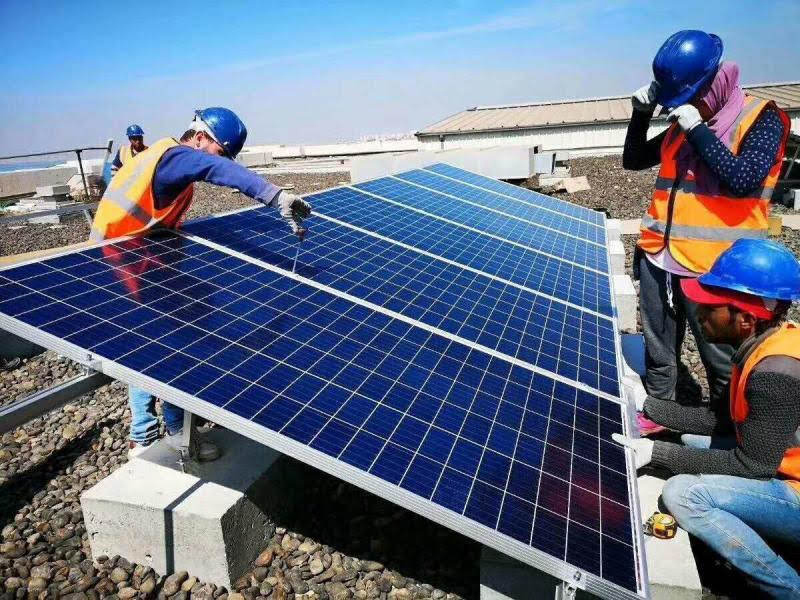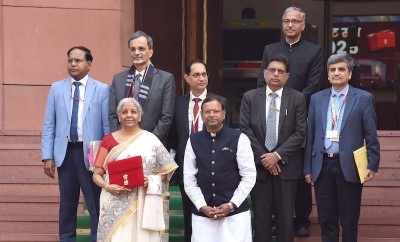
India's renewable revolution gains momentum: IPOs to propel transition from fossil fuels to a green future
New Delhi: Pursuing its commitment to achieve net zero emissions by 2070, India is gradually transitioning away from fossil fuels and embracing renewable energy sources.
In 2022-23, the installed capacity of renewable energy sources (excluding hydro) grew by 12.20%, compared to a 0.49% growth in thermal sources.
This trend indicates that India is shifting its energy landscape, with renewables gaining more prominence in the country's electricity system.
Moreover, energy consumption in India has doubled over the past two decades, and it is projected to increase by at least 25% by 2030.
India's energy imports currently total US$90 billion annually, accounting for nearly 40% of its primary energy, according to Bhupinder S. Bhalla, Secretary of the Ministry of New and Renewable Energy (MNRE).
Given these factors, the importance of renewable energy sources in reducing reliance on non-renewable resources becomes even more critical.
Amidst these challenges, India’s progress in renewable energy has been remarkable.
Supported by strong government policies, a growing domestic market, and an expanding pool of skilled professionals, the country has emerged as a global leader in renewable energy deployment.
In January this year, the International Energy Agency (IEA) reported that India is expected to account for nearly half of the world's additional renewable energy capacity by 2026.
This growth is driven by India’s ambitious renewable energy targets, aiming for 40% of electricity generation to come from renewables by 2030.
India's accelerated transition to renewable energy
As of March 2024, thermal power generation accounts for 56% of India's total installed electricity generation capacity, while renewable energy sources (RES) and hydroelectric power contribute 32% and 11%, respectively, according to a report by the Indian Brand Equity Foundation. Nuclear power makes up only 2% of the total capacity.
Over the years, there has been a decline in thermal-based capacity from 63.3% in 2008-09 to 56% in 2023-24, along with a reduction in hydro-based capacity from 25% to 11%. In contrast, renewable energy capacity has grown significantly from 8.9% to 32% during the same period, according to the report.
.jpg)
Image Credit: Unspalsh
The compound annual growth rate (CAGR) for total installed electricity generation capacity from 2009 to 2023 was approximately 7.7%, with RES growing at 17.4% and other sources at 5.7%.
India's energy sector is undergoing a major transformation as it moves away from fossil fuels towards renewable energy sources.
In 2022-23, RES (excluding hydro) capacity increased by 12.20%, while thermal sources saw a modest growth of 0.49%. This shift highlights India's evolving energy landscape with renewables playing a more significant role in the nation’s electricity grid.
Solar power dominates the renewable energy sector with a 53.4% share, followed by wind power at 34.1%, bio-power and waste-to-energy contributing 8.2%, and small hydro projects making up 3.9%.
In the fiscal year 2023-24, Larsen & Toubro (L&T), an engineering and infrastructure firm, completed various projects including electrifying over 3,400 kilometers of mass transit systems, launching 2.2 gigawatts of solar power, developing 6.2 gigawatts of nuclear power, constructing 3.5 gigawatts of hydroelectric power, and erecting 14.8 million square feet of environmentally friendly buildings.
In L&T's 79th Annual General Meeting (AGM), company's new CMD S N Subrahmanyan announced plans to invest $12 billion over the next five years, with one-third allocated to green energy initiatives.
As part of this commitment, L&T is set to invest approximately $2 billion in its first green hydrogen project, aiming to achieve a capacity of 2-3 million tonnes for green hydrogen and ammonia production, with an overall investment nearing $4 billion.
On July 5, Damodar Valley Corporation (DVC) announced that it has planned to invest Rs 20,000 crore by 2030 to install nearly 4,000 MW of solar capacity, a top official said.
The corporation, created for flood control and development in the Damodar Valley, envisions investment worth Rs 50,000-60,000 crore by 2030 to enhance thermal, pump storage power plants and solar energy, he said.It aims at adding nearly 10,000 MW in thermal and green energy, which will bring its total installed capacity to about 16,700 MW.Of the current 6,700 MW installed capacity of DVC, 6,540 MW is thermal.
Once considered a niche market, renewable energy is now becoming a pivotal source of power in India.
.jpg)
Image Credit: Unspalsh
The sector's growth is underscored by the remarkable performance of green energy stocks, with companies like Inox Wind Energy and KPI Green Energy witnessing substantial returns of 450-500% over the past year, reported equity master.
More than 15 other renewable energy stocks have also posted returns exceeding 100%, according to the report.
While current valuations of renewable energy stocks may appear high, the sector is poised for continued growth and innovation.
Leading Indian firms are increasingly focusing on sustainable initiatives to capitalize on this renewable energy boom.
The upcoming launch of five renewable energy IPOs is expected to further catalyse activity in the renewable energy market.
NTPC
NTPC Green Energy, a wholly-owned subsidiary of NTPC Limited, India's largest power company, focuses on accelerating NTPC's renewable energy growth and expanding its green footprint both domestically and potentially internationally. NTPC Green Energy Ltd (NGEL) recently selected investment bankers for its listing.
The company plans to construct a 60-GW renewable energy portfolio over the next decade, using earnings from share sales to develop its non-fossil fuel companies. This initiative supports the government's goal of achieving net zero carbon emissions by 2070.
According to an ET NOW report, NTPC Limited, a government-owned power generation company, plans to launch an IPO for NTPC Green Energy worth Rs 8,500 crore in September. NTPC Green, with a current operational capacity of 3.4 GW and a pipeline of 26 GW (including 7 GW under implementation), is a 100% subsidiary of NTPC.
Earlier, a PTI report mentioned that NTPC Limited received approval from the Department of Investment and Public Asset Management to proceed with the IPO of its green energy business.
The company aims to raise up to Rs 10,000 crore from the public issue. This IPO will be the largest PSU IPO since LIC's Rs 21,000 crore IPO, which debuted in the market in May 2022.
ONGC Green
Oil and Natural Gas Corporation (ONGC), the largest crude oil and natural gas company in India, established a wholly-owned subsidiary, ONGC Green, on 27 February 2024. ONGC Green operates across various energy business value chains, including renewable energy, bio-fuels/bio-gas, green hydrogen and its derivatives (such as green ammonia and green methanol), energy storage, carbon capture utilization and storage, and LNG.
In March, ONGC approved a Rs 990 million equity investment in ONGC Green, with its board also granting in-principle approval for an additional Rs 11 billion investment. The company plans to expand beyond India, exploring opportunities in international renewable energy markets.
ONGC Green is expected to leverage ONGC's existing infrastructure and expertise for efficient project development and management in the renewable energy sector. These factors position ONGC Green as a potential game changer for the Indian market.
While there have been no official announcements regarding an IPO, the company may consider such plans in the near future.
NHPC Renewable Energy
NHPC Renewable Energy, a subsidiary of NHPC Limited—the largest hydropower producer in India—focuses on developing and managing renewable energy projects, primarily solar and wind power. The company is committed to expanding its renewable energy portfolio, with over 1,300 MW of solar projects in the pipeline.
Earlier this year, NHPC announced plans to boost investments in renewable energy sources. The company aims to allocate 80% of its total capital expenditure to the hydro sector and 15-20% to the solar and hybrid green energy sectors by the end of FY27, thereby enhancing the growth prospects of its subsidiary.
According to Rajendra Prasad Goyal, NHPC's director, NHPC plans to either take NHPC Renewable Energy public or divest its stake to strategic investors via private placement within the next two to three years. Although no specific details of the IPO have been disclosed, NHPC is focused on increasing its renewable energy capacity in the future.
NLC India Green Energy
In October 2023, NLC India, a Navaratna Central Public Sector Enterprise (CPSE) under the Ministry of Coal, established a wholly-owned subsidiary called NLC India Green Energy Limited (NIGEL). This subsidiary is responsible for planning, participating in upcoming renewable energy tenders, and the tendering, execution, and commissioning of renewable energy projects. NIGEL aims to achieve a capacity of 5 GW by 2030 and contribute to carbon emission reduction.
NIGEL has signed a Power Purchase Agreement (PPA) with Gujarat Urja Vikas Nigam Limited (GUVNL) for a proposed 600 MW solar power project at Khavda Solar Park, Gujarat. This project is expected to offset approximately 35.5 million metric tonnes of carbon dioxide emissions during its lifetime and will be the single largest solar project developed by NLCIL to date.
NIGEL has set an ambitious goal of instituting renewable energy projects with a capacity of 6 GW by 2030. In line with this objective, projects totaling 2 GW are currently under development in various regions across India.
While there have been no official announcements regarding an IPO, it could be a possibility in the near future.
SJVN
SJVN Green Energy, a wholly-owned subsidiary of SJVN, a Mini Ratna public sector enterprise under the Ministry of Power, Government of India, focuses on power generation from renewable sources. These include solar parks, wind and hybrid projects, battery energy storage systems, and ventures in wave, biomass, small hydro, and green hydrogen-based businesses.
In April 2024, SJVN Green Energy incorporated a joint venture with Assam Power Distribution Company named SGEL Assam Renewable Energy Limited, issued by the Ministry of Corporate Affairs, Government of India.
This joint venture will focus on power generation from all renewable energy sources, including hydro power, by setting up power plants.
In March, SJVN Green Energy received a 200 MW solar project in an e-Reverse Auction conducted by Gujarat Urja Vikas Nigam, with a tentative construction and development cost of Rs 11 billion. Additionally, the company received a letter of intent for a 500 MW solar project at Gujarat Industries Power Company Park in Khavda, with an investment of Rs 27 billion.
SJVN Green Energy currently has 3.6 GW of assets in its pipeline, set to be commissioned in the next two years. Although no official announcements have been made regarding an IPO, the company plans to invest around Rs 15 billion in renewable capacity addition and may consider going public soon.
Support Our Journalism
We cannot do without you.. your contribution supports unbiased journalism
IBNS is not driven by any ism- not wokeism, not racism, not skewed secularism, not hyper right-wing or left liberal ideals, nor by any hardline religious beliefs or hyper nationalism. We want to serve you good old objective news, as they are. We do not judge or preach. We let people decide for themselves. We only try to present factual and well-sourced news.







